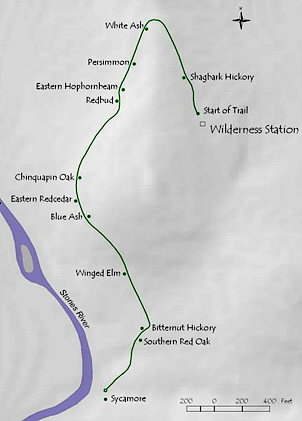|
Though we've tried to include as
many sights and sounds as possible, you'll see and hear much more on
a real trek through the woods. The Virtual Tree Trail is
designed to enhance, not replace, your natural experience.
The Tree Trail at the Wilderness
Station begins at the trailhead and follows the paved trail to the
river overlook beside the West Fork of the Stones River.
The Four Season Virtual Tree Trail of course follows the same path.
Each of the twelve featured Station trees is marked by a
interpretive sign mounted on a square
wooden post about 2-1/2 feet high. The trail winds its way
around a ridge dominated by limestone outcrops. The forest
here is a dry upland oak-hickory forest. The plants and trees
that grow here are called calciphiles; they prefer alkaline,
well-drained soils.
 |
| The Tree
Trail Stations |
Twelve tree species are featured
along the Virtual Tree Trail. You'll be able to stop at each
of the twelve stations and look at the identification
characteristics of each species in each season. If you like,
you can click the link to the dichotomous tree key and key the tree
out.
The dichotomous tree key is
designed to be used in along with the interactive illustrated
glossary. While using the key, or on any other page, simply click
any words that appear in blue to be taken to the glossary. Any
words that appear in red are illustrated, and
clicking on the word will take you to an illustration.
The dichotomous tree key and the glossary can be accessed from any
of the Virtual Tree Trail pages, and appear both in the body of the
page and in the navigation bar at the top left of the page.
After visiting the dichotomous tree key or the glossary, use the
"back" button on your browser to return to the station that you were
visiting.
To navigate around the Four Season
Virtual Tree Trail first select a season at the bottom of this page
or from the choices on the navigation bar at the top left of this
page. You will then be taken to the trailhead at that season
to begin your tour. At the bottom of each page is a link
that will take you to the next station along the trail. You
can also use the navigation bar at the top left of each page to
quickly move along the trail.
At each station there are links
below the navigation bar that will show you the station at each of
the other three seasons.
We recommend setting your speakers
to a fairly low setting to listen to the natural sounds on the web
pages. Louder sounds can be distracting. For each
season, virtual calling animals were placed at various points along
the trail, and your ability to hear them varies with your position
on the trail. Sounds increase in volume as you pass each
virtual animal and decrease in volume as you leave them behind.
You may hear scolding notes as you pass by. Natural sounds are most numerous and varied in
the spring and least numerous in the winter. All sounds
used are identified on the
Sounds Page.
Directions to the Wilderness
Station can be found at the
Wilderness Station web site. Be
sure to dress appropriately for the season, and stop at the
trailhead to read the posted signs there. A pair of binoculars
often comes in handy on the trail, both to see flowers and other
structural parts high in the canopy and to see wildlife along the
trail. A hand lens is another very useful tool to have.
In a pinch, you can turn your binoculars around and look through
them backwards to use them as a magnifying glass for small
identification characteristics.
Please always respect the habitat
and stay on the trails. Since many people enjoy the trail,
please do not remove or alter any leaves, twigs or other parts of the trees
while you are there. Leave them so others may enjoy them too.
Note that all images and recordings
are copyright 2008 Leaps. Please contact Bob English at Leaps
(www.leaps.ms) for permission to use these images and recordings.
Information on inexpensive ways to record natural sounds can also be
found on the Leaps web site.
Acknowledgements:
Laura McCall contributed much to
the design, data collecting and interpretation phases of this
project while she was at the Center for Environmental Education.
Thanks to Cindi Smith-Walters of the Center for Environmental
Education for her leadership throughout the development of the
Virtual Tree Trail. Cindi wrote the
Dichotomous Tree Key
and collaborated on all parts of the web site. We would like to thank Deborah Paschall and the staff of the Wilderness Station for their
assistance and for providing much useful information. Funding
for this project was provided by a special grant by the MTSU
Foundation, and we are grateful to have this opportunity to
contribute to the natural interpretation of this beautiful site.
|

